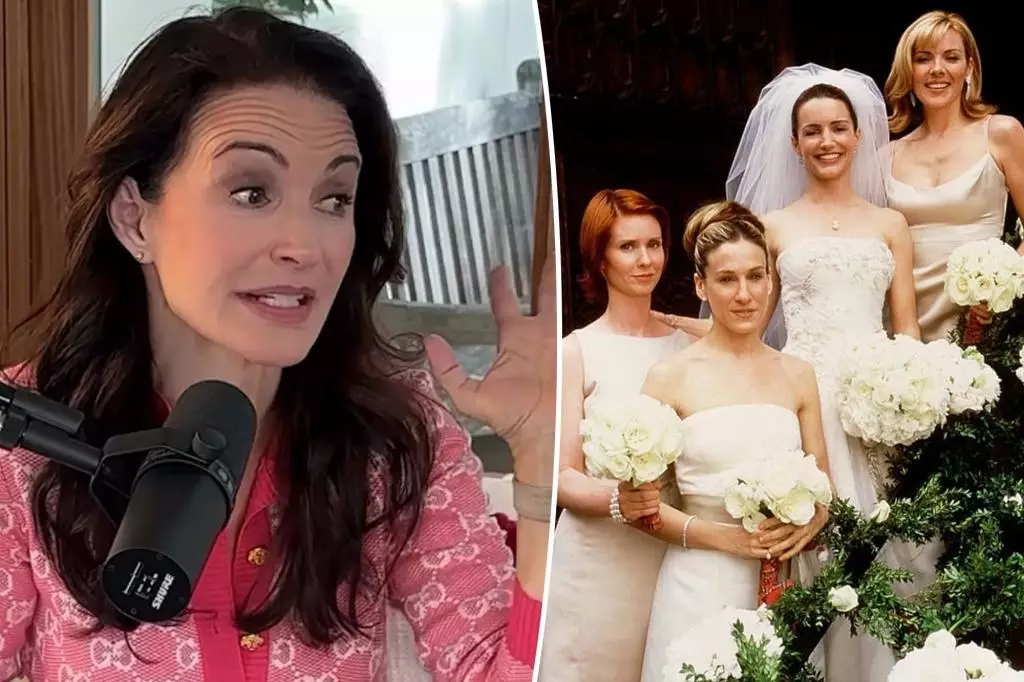In the glamorous world of television, where every outfit can spark conversations and controversies alike, “Sex and the City” stands out as a prime example of how wardrobe choices can lead to interpersonal drama among cast members. Kristin Davis, known for her portrayal of Charlotte York, recently revealed an intriguing anecdote about a lingering tension between her and co-star Sarah Jessica Parker (SJP), who played the iconic Carrie Bradshaw. This wardrobe dispute reportedly stems from a bridesmaid outfit worn during Charlotte’s wedding in Season 3, an incident that illuminates the high stakes of sartorial choices in a show celebrated for its fashion.
During a recent episode of the podcast “Are You a Charlotte?”, Davis recounted a specific moment from the show’s production that has seemingly left a lasting impression on Parker. According to Davis, SJP has continued to harbor ill feelings over the beige Vera Wang dress she wore, stating, “Sarah did not want to wear beige at Charlotte’s wedding.” This commentary sheds light on SJP’s complex relationship with the show’s costumes, highlighting her strong opinions that diverged from the creative direction of the series. This incident is not merely a trivial fashion dispute but seems to encapsulate the intricacies of character representation and individual identity within the narrative framework of “Sex and the City.”
As the show’s creator, Michael Patrick King recalled filming the wedding scene, he described it as “one of the longest days of [his] life.” This is indicative of the stress and the lengthy hours involved in ensuring that every detail, including costume design, aligned with the show’s vision. The demands of production can often lead to a collision of creative ideas, causing friction among the actors. For Parker, her dislike for the bridesmaid dress escalated to the point that she altered it, reportedly cutting and re-styling the gown with tartan elements as a nod to Trey MacDougal’s kilt. Such drastic measures not only reflect her personal style but also demonstrate her commitment to maintaining her character’s unique identity, even if it meant going against the grain of traditional bridal aesthetics.
The evolution of the relationship between the show’s characters is mirrored in the fashion they donned. During another part of the conversation, Davis highlighted the distinct styles of the bridesmaids: Samantha, Miranda, and Carrie each wore variations of beige that showcased their personalities, emphasizing how costume choices served to define character dynamics. For instance, while Miranda’s gown was demure, Samantha’s dress boasted a bold plunging neckline, reflecting her confident persona. Carrie, the ever-stylish protagonist, wore a strapless gown that mirrored Charlotte’s, forging a visual connection yet highlighting her individuality.
This discussion not only reflects the cast’s personal experiences but also explores broader themes about women’s relationships and their evolving identities through fashion. Davis noted the stark contrast when it came to the wedding of Carrie and Big in the first movie; she emphasized that none of the characters wore matching dresses for that occasion, indicating a shift in character development and relationships. The frosty complexities of these interactions often provide fertile ground for drama, making the show not just about fashion but also about friendships, rivalries, and personal growth.
The Aftermath: A Lasting Impression
Davis’s recollections from their time on set leave us pondering the unseen dynamics that play out in the reality of celebrity culture. These discussions often remain under the radar, focusing the lens back on the underlying pressures of perfectionism in the entertainment industry. The revelations about SJP’s feelings toward her beige bridesmaid dress serve as a reminder that even in the most glamorous environments, insecurities can manifest, leading to miscommunication and conflict—all experienced on the backdrop of a beloved series.
The impact of such wardrobe disputes goes beyond mere aesthetics; they remind us that every costume tells a story, not just about the character but about the motivations and relationships of the actors who breathe life into them. As audience members, we often get swept away in the visual splendors, hardly realizing that behind the glitz lie real emotions and relationships woven intricately into the fabric of the show. The world of “Sex and the City” may be rooted in fantasy, but it also reflects authentic human experiences—flaws, conflicts, and all.

